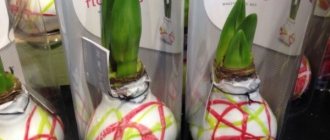- October 18, 2019
- Flowers
- Natalia Miroshnikova
Growing anthurium, or, as it is also called, the flower “male happiness”, can only be grown by experienced gardeners, because this plant cannot be called unpretentious. Transplanting a crop causes particular difficulties for many. And without certain skills and abilities, it is difficult to understand when and how to conduct this event. From our material you will learn how to replant an anthurium at home step by step, and we will also share the secrets of caring for the plant.
When to replant a flower
Anthurium transplantation may be required for the following reasons:
- The flower was purchased in a store. If you just bought an anthurium, then it needs to be replanted within the first three days. The fact is that in stores, flowers are grown in a special peat mixture, which retains moisture for a long time, due to which the plant needs less care. But this substrate is not suitable for long-term flower cultivation, so it needs to be replaced.
- Planned transplant. Young flowers should be replanted annually until they reach five years of age.
- The pot became small. Anthurium transplantation should be carried out when the roots of the flower peek out from the drainage hole. In this case, the event should be started as soon as possible. Otherwise, the roots will begin to entwine the outside of the pot, and then the chance of injuring the plant during the procedure increases several times. And if several roots of a flower are damaged during transplantation, this can even lead to the death of the anthurium.
- Soil depletion. The need for replanting is indicated by the appearance of a white coating on the soil surface.
- Pests. If, even with proper care, the anthurium looks sickly and lethargic, you need to inspect its roots for the presence of insects. And if pests are detected, you should immediately transplant the flower into a new pot.
- Diseases. If you care for a flower incorrectly, the plant may get sick. For example, due to excessive watering, the roots of anthurium can rot. In this case, only an emergency transplant will help save the flower. Also, the action needs to be carried out urgently if mold appears on the soil. This phenomenon indicates that the plant was either overdried or flooded.
- Planting in the wrong soil. If after transplantation the anthurium does not grow, and its green mass looks deplorable, then this means that you initially selected the wrong substrate. And it urgently needs to be replaced. In addition, the procedure must be carried out if the anthurium turns yellow after transplantation. Most likely, you used contaminated soil, and now the plant is suffering from bacteria and pests.
What to do if the plant does not take root or withers?
- The leaves turn yellow at the edges - excess or lack of sunlight.
- The leaves turn yellow, rot and fall off - the plant has contracted fusarium. It is necessary to soak the roots of the flower in a weak solution of Fundazol for half an hour.
- The leaves drooped, the tips turned brown - the draft is to blame.
- The leaves instantly turned yellow - the soil was incorrectly selected or the drainage was not laid. Change the soil, add drainage.
Following the steps of replanting and caring for the plant guarantees long flowering, bright green leaves and a healthy appearance.
The flower of male happiness should stand next to the spathiphyllum - the flower of female happiness. Feng Shui experts believe that the proximity of these plants brings love, harmony and happiness to the family.
Read about how to care for anthurium after transplantation and what problems may arise here.
When is it recommended to replant a flower?
Anthurium transplantation, the care of which we will look at later, is best done in early spring, before the heat sets in. Then the plant can more easily tolerate the stress of the procedure. Of course, if necessary, you can replant the flower at other times of the year. But it is advisable not to carry out this event at temperatures above +30 degrees. In such heat, the roots of the flower stop absorbing moisture normally, which impairs the survival rate of the crop.
Is it possible to replant anthurium during flowering? It is advisable to postpone this activity until the rest period begins. But if the flower gets sick and needs an emergency transplant, then proceed with it immediately. But before changing the soil and pot, cut off all flower stalks. This way the plant will spend energy on acclimatization, and not on supporting buds.
Pot
What is needed to transplant an anthurium? First of all, you need to prepare a suitable pot. Give preference to containers whose depth exceeds their width. As for the material, it is better to choose plastic or glass flowerpots for flowers. As a last resort, a clay pot will do, but only with a glazed inner surface. Otherwise, the roots of the anthurium will grow into the walls of the flowerpot, and you will easily injure them during the procedure.
To choose the appropriate pot size, follow these recommendations:
- When planning a transplant, choose a flowerpot whose diameter is 2-3 cm larger than the previous one.
- If you want to get new flower shoots to use them for propagation in the future, transplant the anthurium into a wider container. This will give impetus to the development of young shoots. But keep in mind that in this case the plant will bloom only after its roots have completely entwined the earthen ball. And this will take a lot of time.
- If you want to achieve beautiful flowering, then give preference to flowerpots with a diameter no more than 2 cm larger than the previous one.
- If during transplantation you also propagate the flower, then for children choose small pots with a volume of 200 g. The mother plant can be transplanted into an old flowerpot, or into an even smaller one if its root system has noticeably decreased.
Once you have decided on the container, do not forget to disinfect it before replanting. To do this, thoroughly wash the flowerpot with laundry soap and then pour boiling water over it. It is especially important to carry out this procedure for pots in which plants were previously grown.
What kind of drainage is needed for growing?
The health and beauty of anthurium depends on the presence of drainage, because these plants do not tolerate stagnation of water in the root system and may die. To create optimal conditions for flower growth, you need to think about good drainage, only in this case excess water will drain away and the roots will breathe.
The following materials are suitable for preparing drainage:
- clay shards;
- broken brick;
- expanded clay;
- gravel;
- crushed stone;
- Styrofoam.
The most popular material for drainage is expanded clay; it is able to absorb excess moisture. These are baked pieces of clay that have a porous structure. You can buy it at flower shops.
When using other materials as drainage, you must follow the following tips:
Priming
The “male happiness” flower prefers loose, fertile soil with a slightly acidic reaction. And this plant will be suitable for a mixture intended for orchids. If you want to create soil for replanting anthurium yourself, then mix the following components in equal parts:
- leaf soil;
- peat;
- coniferous soil;
- coarse sand.
Carefully move all components and remove large parts. After this, disinfect the substrate by placing it in the freezer for a day. You can add a little charcoal and pine chips to the finished soil.
Step-by-step instructions: how to breed in open ground?
Anthurium is afraid of direct sunlight . It is best to plant in a shaded place. Let's take a closer look at how to transplant male happiness into open ground:
- Dig a hole 5 cm deeper than the height of the plant's pot.
- Fill the bottom of the hole with polystyrene foam, drainage or non-sharp broken shards about 5 cm thick.
- Remove the anthurium along with the soil.
- Place the flower in the hole and sprinkle it with specially prepared soil. Lightly compact the soil with your hands.
Anthurium is a heat-loving and whimsical indoor flower . Planting in open ground is not advisable.
First transplant after purchase
The purchased anthurium must be replanted within the first three days. Why such urgency? The fact is that the sooner you carry out this event, the faster the plant will acclimatize to the conditions of your apartment. Please note that this flower is poisonous, so be sure to wear gloves when handling the plant in any way.
So, how to transplant an anthurium at home step by step:
- Remove all flower stalks, if any.
- Carefully remove the plant from the pot.
- Using a wooden stick, carefully remove all the peat soil in which the flower was grown in the store.
- Treat the roots with any fungicide, such as Fitosporin or Fitolavin.
- Place drainage made of broken bricks, pebbles or expanded clay at the bottom of the new container. Please note that this layer should occupy a quarter of the volume of the flowerpot. Cover the drainage with sphagnum moss.
- Place the plant in the center of the pot and carefully straighten the roots. Fill the voids with substrate so that the growing point is flush with the ground.
The same principle is used to replant anthurium when the roots rot. If the room is warm, you can moisten the flower immediately after the event. If the room conditions are cool, then carry out the first watering 1-2 days after the procedure. By this point, the injured roots will have healed and will not rot when they get wet.
Why do you need to transplant “male happiness” to another land?
It is necessary to replant the anthurium so that the plant receives all the important trace elements and nutrients. When a flower grows out of a pot, there is no free space left inside to grow. Roots fill the entire space. The flower can no longer develop well and eat fully.
The soil needs to be changed from time to time. Buy ready-made soil, which should contain crushed bark, expanded clay, sphagnum moss, and charcoal. Universal soil mixtures will not work.
In addition to transplantation during a favorable period of rest, there are urgent situations. The reasons may be different:
- unpleasant smell of earth;
- rotting of the root system;
- you need to replant a purchased flower from a peat mixture;
- plant disease;
- replacing a damaged pot.
If help is not provided in time, the flower may die.
Planned transplant
Carry out the event as follows:
- The day before the event, moisten the soil well using bottom watering. To do this, place the flower pot in a container filled with water for half an hour.
- Carefully remove the plant from the old pot. Using a wooden stick, carefully remove the earthen lump, being careful not to damage the roots of the anthurium.
- Examine the root system of the flower. If you find pests, treat the shoots with an insecticide, such as Actellik. And also remove all rotten and damaged roots. Don't forget to treat the cut areas with crushed charcoal.
- Remove all inflorescences and damaged leaves.
- Place a layer of drainage ¼ full at the bottom of the new pot. For these purposes, use brick chips, expanded clay, or pebbles. Cover the drainage with sphagnum moss.
- Place the plant in the center of the new pot and carefully spread out the roots. Fill the voids with soil, and cover the anthurium with sphagnum moss on top.
How to replant anthurium
To transplant a flowering anthurium, it is removed from the pot after first soaking the soil with water.
- Transplantation by the transshipment method involves transferring the roots of the flower with soil into a new pot with the addition of fresh substrate on the sides.
- Dividing the bush involves cutting the root sponge into several separate segments.
- If you are planting plants with a diseased root system, then after removing the anthurium from the pot, the root system must be washed with water, all damaged areas should be cut off with pruning shears, the cuts should be treated with charcoal, and only after that it is ready to go into a new pot.
The first layer of planting soil, which is placed in the planting container, is expanded clay chips. The height of the expanded clay drainage layer should be equal to 1/6 of the total height of the pot. The first layer prevents water from stagnating after watering the plant. The second layer is pre-prepared soil. When replanting a flower, the root collar is not deepened, leaving it above the surface of the last layer of soil.
Transplantation and propagation
Anthurium can be easily propagated during transplantation. To do this, after you remove the flower from the pot, carefully separate the children from the mother bush. Each of these divisions should have several leaves and a strong root system. Place the children in individual pots using the same algorithm as for replanting adult plants.
Possible errors and their elimination
Sometimes after transplantation, anthurium develops problems. If you solve them in time, the consequences will be minimal.
It happens that the pot chosen for the anthurium is too large, so it does not bloom. In this case, simply transplant it into a smaller container. Also, problems with flowering may occur if the soil is too heavy. To eliminate this error, transplant the bush into suitable soil.
When a plant's leaves turn black, this indicates an excess of moisture. Let the soil dry out well between waterings. And if mold has formed on it, most likely the root system of the plant has begun to rot. In this case, replant the anthurium in healthy soil, removing rotting areas.
Humidity
It is important to create conditions with high humidity for the transplanted anthurium. To do this, install a special device next to the pot - a humidifier. If you do not have such a device, then place the flower in the aquarium. If this is not possible, then at least keep containers of water near the plant. Better yet, place the pot on a tray with damp expanded clay or moss, but make sure that the moisture does not reach the drainage hole. Otherwise the flower will suffocate.
In addition, do not forget to spray the foliage of the crop daily. Use warm and filtered water for this, and during the procedure, make sure that moisture does not get on the anthurium buds.
How to moisturize a plant
For the first two weeks after transplantation, water the flower regularly, but moderately. If you carried out the procedure in the summer, then moisten the soil with a small amount of water every 4 days. In winter, it is enough to water the plant once a week. And use for irrigation only settled and filtered water, the temperature of which is 2-3 degrees higher than room temperature. Also, do not forget to drain excess liquid from the pan 20 minutes after watering. Otherwise, the roots of the plant will rot.
After two weeks of gentle watering, return to the normal irrigation regime, that is, moisten the flower when the substrate dries 1/3 of the volume.











